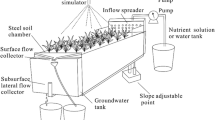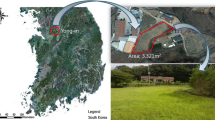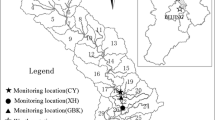Abstract
In this study, a field experiment was conducted to examine the retention efficiencies of vegetative filter strips (VFS) on agricultural nonpoint source pollutants. Furthermore, the numerical model VFSMOD was used to predict the VFS performance and linked to a simplified nitrogen transport algorithm. The results indicated that the long filter, low grass spacing, low initial soil water content, and low inflow rate had high VFS retention efficiencies for surface runoff, sediment, and N. However, shallow water table depths (> 1.8 m) had little influence on VFS retention efficiencies, suggesting that shallow WTD (> 1.8 m) need not be considered when constructing VFS. The retention efficiencies varied greatly from 16.55%, 21.15%, 24.70%, 14.57%, 21.86%, and 27.70% to 81.51%, 87.58%, 88.47%, 87.56%, 82.97%, and 89.95% for surface runoff, sediment, TN, NH4+, NO3−, and PN, respectively. The VFSMOD can predict hydrology and sediment transport well for the experimental events with peak outflow rate from VFS greater than 0.0004 m3/s. The good VFSMOD predictions in surface runoff (Ceff = 0.985 for TRF, Ceff = 0.969 for RDR) and sediment (Ceff = 0.998 for MSF, Ceff = 0.960 for SDR) also resulted in good predictions of N (Ceff = 0.913 for MDN). Overall, our study demonstrated that VFSMOD is a useful tool in formulating management schemes for retaining nonpoint source pollutants using VFS, provided local meteorology, rainfall intensity, agricultural fertilization policies, and other influencing factors are considered.


Source area




Similar content being viewed by others
Data Availability
The datasets generated during and/or analyzed during the current study are available from the corresponding author on reasonable request.
References
Abu-Zreig, M. (2010). Factors affecting sediment trapping in vegetated buffer strips: Simulation study using VFSMOD. Hydrological Processes, 15(8), 1477–1488.
Abu-Zreig, M., Rudra, R. P., Lalonde, M. N., Whiteley, H. R., & Kaushik, N. K. (2004). Experimental investigation of runoff reduction and sediment removal by vegetated filter strips. Hydrological Processes, 18(11), 2029–2037.
Carluer, N., Lauvernet, C., Noll, D., & Muñoz-Carpena, R. (2017). Defining context-specific scenarios to design vegetated buffer zones that limit pesticide transfer via surface runoff. Science of the Total Environment, 575, 701–712.
Cisneros, J. M., Grau, J. B., Antón, J. M., Prada, J. D. D., Cantero, A., & Degioanni, A. J. (2011). Assessing multi-criteria approaches with environmental, economic and social attributes, weights and procedures: A case study in the Pampas, Argentina. Agricultural Water Management, 98(10), 1545–1556.
Deletic, A., & Fletcher, T. D. (2006). Performance of grass filters used for stormwater treatment—A field and modelling study. Journal of Hydrology, 317(3–4), 261–275.
Department of Ecology and Environment of Hubei Province. (2018). Monthly Report of Surface Water Environmental Quality in Hubei Province, August 2018. China, Department of Ecology and Environment of Hubei Province.
Dorioz, J. M., Wang, D., Poulenard, J., & Trevisan, D. (2006). The effect of grass buffer strips on phosphorus dynamics—A critical review and synthesis as a basis for application in agricultural landscapes in France. Agriculture Ecosystems & Environment, 117(1), 4–21.
Dosskey, M. G., Helmers, M. J., & Eisenhauer, D. E. (2006). An approach for using soil surveys to guide the placement of water quality buffers. Journal of Soil and Water Conservation, 61, 344–354.
Dosskey, M. G., Hoagland, K. D., & Brandle, J. R. (2007). Change in filter strip performance over ten years. Journal of Soil and Water Conservation, 62, 21–32.
Foster, G. R., Lane, L. J., Nowlin, J. D., Laflen J. M., Young R. A. (1980). A model to estimate sediment yield from field-sized areas development of model. In: Knisel, W.G. (Ed.), CREAMS: A field-scale model for chemical, runoff, and erosion from agricultural management systems, vol. II. USDA—Science Education Administration Conservation Report 26, pp. 193–281.
Fox, G. A., Muñoz-Carpena, R., & Purvis, R. A. (2018). Controlled laboratory experiments and modeling of vegetative filter strips with shallow water tables. Journal of Hydrology, 556, 1–9.
Giri, S., Mukhtar, S., & Wittie, R. (2010). Vegetative covers for sediment control and phosphorus sequestration from dairy waste application fields. Transactions of ASABE, 53(3), 803–811.
Guertault, L., Fox, G. A., Halihan, T., & Muñoz-Carpena, R. (2021). Quantifying the importance of preferential flow in a riparian buffer. Transactions of the ASABE, 64(3), 937–947.
Haan, C. T., Barfield, B. J., & Hayes, J. C. (1994). Design hydrology and sedimentology for small catchments. Academic Press.
Hayes, J. C., Barfield, B. J., & Barnhisel, R. I. (1984). Performance of grass filters under laboratory and field conditions. Transactions of the ASAE—American Society of Agricultural Engineers (USA), 27(5), 1321–1331.
Krause, P., Boyle, D. P., & Bäse, F. (2005). Comparison of different efficiency criteria for hydrological model assessment. Advances in Geosciences, 5, 89–97.
Kuo, Y. M., & Muñoz-Carpena, R. (2009). Simplified modeling of phosphorus removal by vegetative filter strips to control runoff pollution from phosphate mining areas. Journal of Hydrology, 378, 343–354.
Kuo Y. M. (2007). Vegetative filter strips to control surface runoff phosphorus transport from mining sand tailings in the upper peace river basin of Central Florida. Ph.D. Dissertation, University of Florida.
Lacas, J. G., Carluer, N., & Voltz, M. (2012). Efficiency of a grass buffer strip for limiting diuron losses from an uphill vineyard towards surface and subsurface waters. Pedosphere, 22(4), 580–592.
Lambrechts, T., François, S., Lutts, S., Muñoz-Carpen, R., & Bielders, C. L. (2014). Impact of plant growth and morphology and of sediment concentration on sediment retention efficiency of vegetative filter strips: Flume experiments and VFSMOD modeling. Journal of Hydrology, 511(7), 800–810.
Lauvernet, C., & Muñoz-Carpena, R. (2018). Shallow water table effects on water, sediment and pesticide transport in vegetative filter strips: Part B. model coupling, application, factor importance and uncertainty. Hydrology & Earth System Sciences Discussions, 22(1), 71–87.
Li, R., & Kuo, Y. M. (2021). Effects of shallow water table depth on vegetative filter strips retarding transport of nonpoint source pollution in controlled flume experiments. International Journal of Environmental Research, 15, 163–175.
Liu, X., Zhang, X., & Zhang, M. (2008). Major factors influencing the efficacy of vegetated buffers on sediment trapping: A review and analysis. Journal of Environmental Quality, 37(5), 1667–1674.
Luo, M., Pan, C., & Liu, C. (2020). Modeling study on the time-varying process of sediment trapping in vegetative filter strips. Science of the Total Environment, 725(5), 1–10.
Muñoz-Carpena, R., Parsons, J. E., & Gilliam, J. W. (1993). Numerical approach to the overland flow process in vegetative filter strips. Transactions of the ASAE, 36(3), 761–770.
Muñoz-Carpena, R., Parsons, J. E., & Gilliam, J. W. (1999). Modeling hydrology and sediment transport in vegetative filter strips. Journal of Hydrology, 214(1–4), 111–129.
Muñoz-Carpena, R., Fox, G. A., & Sabbagh, G. J. (2010). Parameter importance and uncertainty in predicting runoff pesticide reduction with filter strips. Journal of Environmental Quality, 39(2), 630–641.
Muñoz-Carpena, R., Lauvernet, C., & Carluer, N. (2018). Shallow water table effects on water, sediment, and pesticide transport in vegetative filter strips: Part A. nonuniform infiltration and soil water redistribution. Hydrology & Earth System Sciences, 22(1), 1–32.
Muñoz-Carpena R., Parsons J.E. (2014). VFSMOD-W model documentation and user’s manual. University of Florida.
Nash, J. E., & Sutcliffe, J. V. (1970). River flow forecasting through conceptual models. Part 1—A discussion of principles. Journal of Hydrology, 10, 282–290.
Plunge, S., Gudas, M., & Povilaitis, A. (2022). Effectiveness of best management practices for non-point source agricultural water pollution control with changing climate—Lithuania’s case. Agricultural Water Management, 267, 1–14.
Poletika, N. N., Coody, P. N., Fox, G. A., et al. (2009). Chlorpyrifos and atrazine removal from runoff by vegetated filter strips: Experiments and predictive modeling [J]. Journal of Environmental Quality, 38(3), 1042–1052.
Rahman, A., Rahman, S., & Cihacek, L. (2014). Influence of soil pH in vegetative filter strips for reducing soluble nutrient transport. Environmental Technology, 35(14), 1744–1752.
Reichenberger, S., Bach, M., Skitschak, A., & Frede, H. G. (2007). Mitigation strategies to reduce pesticide inputs into ground- and surface water and their effectiveness: A review. Science of the Total Environment, 384(1–3), 1–35.
Sabbagh, G. J., Fox, G. A., Kamanzi, A., Roepke, B., & Tang, J. Z. (2009). Effectiveness of vegetative filter strips in reducing pesticide loading: Quantifying pesticide trapping efficiency. Journal of Environmental Quality, 38(2), 762–771.
USDA. (2000). Conservation buffers to reduce pesticide losses. USDA Natural Resources Conservation Service.
Xiao, B. O., Wang, Q., Wang, H., Wu, J., & Yu, D. (2012). The effects of grass hedges and micro-basins on reducing soil and water loss in temperate regions: A case study of Northern China. Soil & Tillage Research, 122(122), 22–35.
Yang, F., Yang, Y., Li, H., & Cao, M. (2015). Removal efficiencies of vegetation-specific filter strips on nonpoint source pollutants. Ecological Engineering, 82, 145–158.
Yang, T., Wang, Q. J., Liu, Y. L., Zhang, P. Y., & Wu, L. (2016). A comparison of mathematical models for chemical transfer from soil to surface runoff with the impact of rain. CATENA, 137, 191–202.
Yu, C., Duan, P., Yu, Z., & Gao, B. (2019). Experimental and model investigations of vegetative filter strips for contaminant removal: A review. Ecological Engineering, 126, 25–36.
Zou, L., Liu, Y., Wang, Y., & Hu, X. D. (2020). Assessment and analysis of agricultural non-point source pollution loads in China: 1978–2017. Journal of Environmental Management, 263, 1–10.
Funding
This work was financially supported by the Initiation Research Fund of East China University of Technology (DHBK2019111), the National Science and Technology Council (NSTC 112-2313-B-415-003), the Open Research Fund of Jiangxi Province Key Laboratory of the Causes and Control of Atmospheric Pollution (AE2206), and the Science and Technology Project of Jiangxi Education Department (GJJ2200765).
Author information
Authors and Affiliations
Corresponding author
Ethics declarations
Conflict of Interest
The authors declare no competing interests.
Additional information
Publisher's Note
Springer Nature remains neutral with regard to jurisdictional claims in published maps and institutional affiliations.
Rights and permissions
Springer Nature or its licensor (e.g. a society or other partner) holds exclusive rights to this article under a publishing agreement with the author(s) or other rightsholder(s); author self-archiving of the accepted manuscript version of this article is solely governed by the terms of such publishing agreement and applicable law.
About this article
Cite this article
Li, R., Liu, Ww., Zhao, E. et al. Retention Efficiencies of Vegetative Filter Strips in Reducing Agricultural Nonpoint Source Pollution in Jianghan Plain: Experiments and VFSMOD Modeling. Water Air Soil Pollut 235, 151 (2024). https://doi.org/10.1007/s11270-023-06859-8
Received:
Accepted:
Published:
DOI: https://doi.org/10.1007/s11270-023-06859-8




